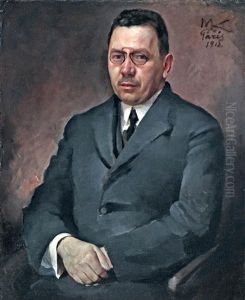Miroslav Kraljevic Paintings
Miroslav Kraljević was a pivotal figure in Croatian art, whose brief but intense career left a lasting impact on the development of modern art in Croatia and the region. Born on December 14, 1885, in Gospić, in what was then part of Austro-Hungarian Empire (now Croatia), Kraljević's early life in a rural setting influenced much of his later work, which often depicted scenes of rural life, landscapes, and portraits with a distinctive personal and emotive style. Despite his early death at the age of 27 on April 16, 1913, Kraljević's oeuvre is considered a crucial bridge between traditional genres and the modernist movements that would redefine Croatian art in the 20th century.
Kraljević's education in art began at the Royal Academy of Arts in Munich, Germany, where he was exposed to the latest trends in European art, including Impressionism, Post-Impressionism, and early expressions of Expressionism. His style evolved rapidly, showcasing a remarkable ability to assimilate various influences while developing a unique artistic language. His time in Munich was followed by a stay in Paris, the epicenter of the avant-garde, which further enriched his approach to painting and drawing.
Upon returning to Croatia, Kraljević embarked on a prolific period, producing landscapes, urban scenes, portraits, and self-portraits that reflected his technical virtuosity and deep introspection. His work is characterized by a bold use of color, dynamic brushwork, and a focus on capturing the psychological depth of his subjects. Kraljević was also known for his etchings and drawings, which demonstrate his keen observational skills and ability to distill complex scenes into compelling compositions.
Despite his contributions to Croatian art, Kraljević's career was cut short by his untimely death from tuberculosis. His legacy, however, endures, and he is celebrated as a pioneer who challenged the conventions of his time and opened new pathways for the generations of artists that followed. His work is held in high esteem and can be found in major Croatian museums, including the Modern Gallery in Zagreb, which houses an extensive collection of his paintings and drawings. Through his innovative approach and expressive power, Miroslav Kraljević remains a seminal figure in the history of Croatian art, whose influence is felt to this day.


